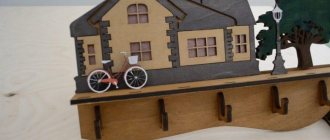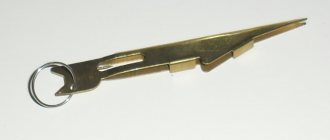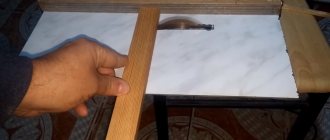Unfortunately, the design of many walk-behind tractor models does not include lighting equipment. But often a headlight on a walk-behind tractor is simply necessary, because it is not always possible to finish work in the field before dark. And when using a walk-behind tractor as a vehicle on the roads, you absolutely cannot do without a headlight.
Some manufacturers specifically sell ready-made kits of headlights, toggle switches and wires separately, thereby providing you with hassle and additional profit for yourself. But you don’t have to spend extra money on purchasing “special” lighting equipment, because connecting the light to a walk-behind tractor with your own hands is easier than it seems at first glance.
First you need to understand the structure of your walk-behind tractor. Typically, the headlight is powered by battery energy, which is charged from a generator and whose power is not always enough for high-quality lighting. In this case, you should not rush and install another additional generator, because this is not always simple, cheap and safe. The easiest way would be to use a kind of generator built into the engine, consisting of a flywheel with magnets and a lighting coil. To connect lighting to a walk-behind tractor with a single-cylinder engine, you need a lighting coil of at least 3 amperes. It will be able to power a headlight with a power of up to 40 W.
Before installing the headlight on the walk-behind tractor, you need to assemble a single electrical circuit to connect the lighting system to the generator. The drawing below shows in detail all the elements of this circuit.
6DM18 batteries - battery features
Batteries marked 6DM18 are considered the most popular in the domestic market.
Today they are actively used to complete walk-behind tractors produced by such well-known brands as Zubr, Cascade and Centaur. The good characteristics of this type of battery allow them to be successfully used for both gasoline and diesel walk-behind tractors that are intensively used in regions with bad weather conditions. At the same time, the battery can withstand high loads, does not wear out for a long time and regularly supplies energy to all electrical appliances included in the walk-behind tractor.
The standard sizes of batteries of this type allow them to be installed on walk-behind tractors of any class. There is no need to use adapters or additional fasteners for this. These batteries can withstand a large number of charge/discharge cycles, which, together with high quality, durability and relatively low cost, makes them one of the most popular batteries among buyers in the domestic market.
Lighting for equipment of any class
Motoblocks should be distinguished into certain classes:
- lightweight electric/gasoline engine, the device of which is from 10 to 60 kg;
- medium gasoline engine weighing from 60 to 100 kg;
- heavy class - gasoline/diesel engine with air or liquid cooling, power over 9 hp.
Lightweight walk-behind tractors are used for processing small areas (for example, dachas). The middle class is used in a fairly wide range - from cultivating land to pumping water using mounted and trailed equipment. The heavy class is suitable for developing virgin soil, cultivating areas, and transporting heavy loads in rural areas. In any operating conditions, you have to think about how to make light for the walk-behind tractor.
The walk-behind tractor can be used not only for plowing the land, but is also well suited for transporting goods. A trailer cart is used for this. The cart can be equipped with additional headlights. All that remains is to read the instructions on how to connect the headlight.
Lighting options for walk-behind tractor
The choice here is small, it all depends on the model of your walk-behind tractor. Medium walk-behind tractors are usually equipped with a belt drive. There is a pulley on the motor shaft that transmits torque to the box using a belt. Lighting for such walk-behind tractors can be done by installing a generator and connecting a headlight to it.
Heavy walk-behind tractors, for example “Agro”, “Belarus”, “Ugra”, do not have a belt drive in their design. The engine of such walk-behind tractors is connected directly to the box, so installing a generator on heavy walk-behind tractors can be problematic. How to make a light on a walk-behind tractor that does not have pulleys in its design? In such cases, power to the headlight is taken from the battery.
Some walk-behind tractors, usually made in China, are already equipped with standard lighting and even an electric starter. But, as it turned out in fact, they are all equipped with low-quality generators. The light on such walk-behind tractors is very dim, flickering, and is not suitable for illuminating the road at night. If you don’t know how to make a light on a Chinese walk-behind tractor, an example will be given below.
Specifics of lighting selection and installation
Before installing the headlight on the walk-behind tractor, you need to decide on the equipment used. The choice of lamp for lighting depends on the complexity and nature of the work being carried out, as well as lighting requirements.
The more light you need at night, the greater the power of the selected lamp should be.
There are also technical issues when installing headlights. If the generator power is not enough to provide a constant flow of light, 12 V batteries are used. It is recommended to use lightweight equipment so as not to increase the load on the walk-behind tractor.
For walk-behind tractors with belt drive
A special feature of belt drive technology is the absence of a generator. Therefore, the owner of special equipment must independently install electrical equipment using plumbing tools and additional spare parts. They can be removed from a car or other equipment.
The main thing during installation is to replace the generator pulley with one that matches the belt drive of the walk-behind tractor. For greater convenience, the electrical equipment is mounted at the back, after which its functionality is checked and the lighting is connected.
For heavy walk-behind tractors
Heavy walk-behind tractors do not use generators or belt drives, so batteries are used for the light source.
It is recommended to install batteries from motorcycles, since they have sufficient power, small dimensions and weight.
The only drawback is that you need to make and secure the battery mount yourself. An iron profile or corners welded into a single structure are suitable for this. And for greater reliability, the product is treated with soft material, after which the battery is attached.
Possible malfunctions and their elimination
Even if a high-quality generator is installed in the design of the walk-behind tractor, including one made by yourself, it periodically requires repair. If serious faults are detected, it is recommended to contact specialists, however, simple breakdowns can be repaired independently. Most often observed:
- element overheating;
- short circuit due to moisture ingress;
- voltage surges and other malfunctions.
If the product begins to heat up significantly, most likely the problem lies in a malfunction of the capacitor, which will need to be replaced with an analogue of a larger capacity to restore the device to working condition.
Short circuits due to moisture are a serious problem that will require careful troubleshooting and replacement of burnt-out elements after drying. Voltage fluctuations and malfunctions most often require replacing the brushes, after which the generator begins to function correctly.
Connecting and checking the headlight
The procedure for installing light on equipment does not take much time.
Basic steps on how to connect a headlight to a walk-behind tractor:
- install an external power source for the light;
- connect the wires to electricity and the headlight;
- add a switch to turn the light on and off;
- perform final installation of elements.
After this, testing of lighting, uninterrupted operation and reliability of the switch is carried out.
Disc plow: algorithm of actions
A disc plow-hiller is used to prepare even furrows for planting vegetables. Using the drawings, you can control the progress of the assembly and avoid shortcomings.
The manufacture of a disc plow is carried out according to the described scheme:
- Support corner as a basis. It is made from a corner with equal sides, its shelves after cooling should converge at an angle of 700;
- The sock is welded to the corner. The heel is welded to the thrust bar;
- The cheeks are secured to the support corner with loops. The end sides of the cheeks should not rest against each other when opened;
- The rotating mechanism is welded to the stop angle at a right angle.
Finally, you need to adjust the plow cheeks. They are fixed with a vice and adjusted until they are directed in different directions.
You can use different types of lighting elements:
- Additional headlights from a moped, scooter, tractor, car or other vehicle at your disposal.
- You can buy a used headlight on the automobile market in places where transport and electrical parts are dismantled and sorted.
- You can select a new headlight taking into account the color of the mini-tractor itself.
The ideal option is to choose a headlight for a scooter or small motorcycle. In addition, it is worth purchasing an electrical wire of the required length and a toggle switch for switching the lighting.
It is most convenient to connect the toggle switch to the steering column near the gear shift lever. The headlight itself may be located in the steering column or on the front of the engine. But the first option will be preferable. On an engine, the headlight will constantly become dirty while the mechanism is moving, especially sometimes in the rain.
The next step in connecting the headlight is to run wires to it. The mechanism may include a connection point for the factory headlight. In this case, we simply connect a wire to it. If there is none, then the power should be removed from the oil pressure warning lamp terminal.
Also, many are concerned about the question of whether it is possible to make light on a walk-behind tractor without a generator. It is worth noting that a battery is required, which will be installed using a quick-release mount and recharged in the workshop.
For a walk-behind tractor, there are wide limits to its use, ranging from plowing land, pumping water to cultivating virgin soil and transporting heavy loads.
MOTOR-BLOCKS and motor-cultivators (cultivators)
The best models of walk-behind tractors and walk-behind cultivators are on sale in our store wholesale and retail, as well as on credit at low prices. There are many tasks on a personal plot for which it is better to use a walk-behind tractor rather than primitive garden tools. This small device is otherwise called a mini-tractor, has manual control, and can be equipped with a gasoline or diesel engine with a power of kW. There are also light walk-behind tractors with an electric motor, which are used only for cultivating the soil. The walk-behind tractor is a universal tool that can be used to loosen the soil, control weeds and even transport small loads.
The generator for the walk-behind tractor is an important part of the unit. It converts mechanical energy into electrical energy.
Tractor from the Neva MB walk-behind tractor
In the material presented to your attention, we will discuss, as you understand, the creation of a mini-tractor from the Neva . Today, when Agriculture has undergone a reorientation from collective farming to individual farming, new equipment was also required that would be more suitable for private farming, with small dimensions, weight and low fuel consumption. When running your own farm and farmstead, you should save on everything, otherwise you won’t see any profit.
A walk-behind tractor, small, strong and unpretentious, came to the rescue of new farmers. This technique has shown itself to be very good and has gained love and respect among the villagers; a better housekeeping assistant cannot be found. Also, over the past years, walk-behind tractors have undergone a number of changes and improvements; many craftsmen began to make mini-tractors out of them, which immediately became very popular among farmers.
So our author decided to make a mini-tractor from his walk-behind tractor, because operating a tractor is much more convenient. So let's look at what the craftsman needed to create the tractor and how he carried out the assembly work.
1) walk-behind tractor "Neva" 2) steering column 3) metal corner 4 rods 5) wheels "VAZ" 6) metal 1 mm
Installation of lighting on the Neva MB2 walk-behind tractor, completion of work.
1) welding machine 2) grinder 3) drill 4) set of wrenches 5) hammer 6) pliers
The process of assembling a Tractor from a walk-behind tractor " Neva "
And so, first of all, the author made a drawing of the frame, which he would then work on. Prepared all the main parts and components. Next I started cutting the corners to create the frame. Parts of the corners, sawn to specified dimensions, are welded into a single frame structure. I shortened the bridge from the Moskvich car. Starts assembly.
READ Do-it-yourself mini tractor on tracks from a walk-behind tractor
How to choose the right lighting coil
Often, when using Lifan engines in technology and households, it becomes necessary to connect various electrical appliances. Many craftsmen are trying to use additionally installed generators. But this is expensive and not always convenient. We have to come up with complex designs, adapt pulley and belt systems. This greatly complicates the entire mechanism, and most importantly, the reliability of the entire system is lost. An excellent way out of this situation is a generator built into the engine (flywheel with magnets plus a lighting coil). The Lifan company offers its customers several options for such generators.
The standard coil for Lifan is a 0.6 Ampere (12V) coil for a standard single-cylinder engine and a 3 Ampere (12V) coil for a standard two-cylinder engine. Due to the fact that their power is too low to connect third-party consumers, such coils are only sufficient to start the engine and operate it.
If you want to connect additional useful consumers to the engine (for example, lighting lamps, battery charge, receiver, navigator, etc.), then more powerful coils must be used for these purposes.
In this case, the minimum power for a single-cylinder engine will be a 3 Ampere coil; through it you can connect a lamp up to 40 W. Further, if you need more powerful consumers, then the coil will be 5 Ampere or 7 Ampere. You can also directly connect lamps, for example halogen ones, to them, since the current is not too high, and in this case the relay regulator is not necessary in the circuit. The total power of connected devices when using a 5 Ampere coil increases to 60 Watt, and a 7 Ampere coil increases to 84 Watt. (Everyone probably remembers well from the school physics course how to find the power “P” with the current strength “I” and voltage “U” known to us. We simply find the product of the current strength and voltage P = IxU). All of the above coils produce alternating voltage (AC). Thus, it is clear that lamps and devices need to be selected accordingly.
However, if there is a need to charge the battery installed on the equipment, then you will need constant voltage (DC) at the output. The above coils alone will no longer be enough. Then you will additionally need to install a relay regulator (or rectifier) in the electrical circuit. The same is the case if you already use more powerful coils of 18 Amperes or 20 Amps, and they are usually installed on 188F (13 hp) or 190F (15 hp) single-cylinder engines, or two-cylinder 2V77 (17 hp), 2V78 (21 hp), then for stable operation of the devices you will need, in addition to the coil, to use a voltage regulator relay. In the case of coils more powerful than 7 Amps - always. For this purpose, the Lifan company produces, for example, this relay-regulator (18 Amperes), or this relay-regulator (20 Amperes). However, such powerful coils and corresponding flywheels (plus a relay-regulator) are supplied as spare parts in very limited quantities. Lifan does this deliberately. The main reason for this is that customer modifications (do-it-yourself) are not covered by the manufacturer's warranty. On our website we offer our clients such “pumped up” engines of exclusively original factory assembly and design. All of them are assembled at the Lifan plant, specifically according to the requests of the Russian consumer. And they are fully covered by the entire factory warranty.
Improvements to the Neva walk-behind tractor | Electro-Hobby
Improvements to the Neva walk-behind tractor
Overall the unit is quite decent. but light.
"I am strong! I'm very strong!! I'm the strongest. »
A horse catches up with him and gives him a good kick.
"I am strong! I'm very strong!! But very light. »
The first changes that befell the device are visible to the naked eye.
During the first plowing on sandy soil, one of those watching its work leaned on the machine. The difference was felt immediately. as well as how much weight the device would need to add.
As a result, the existing load of 25 kg was adapted to the front part. After which the walk-behind tractor not only acquired more weight, but also its center of gravity moved to the wheel axle, which made it easier to control.
As a result of selecting the required processing width (important when cutting furrows for planting potatoes, more on that later), the axle extension was installed on only one axle. As a result, the width between the wheels became close to 60cm. And the second extension was successfully attached to the front bracket for attaching the weighting material.
Power 6hp It is quite enough for plowing even at the minimum speed of the unit. The only drawback is when you try to turn the ground into “fluff” with cutters at a frantic 2nd speed. The motor quickly (within a few minutes) overheats. Which is logical, the second speed is quite fast (at minimum speed you have to run after the unit) and is not intended for power work.
I must say that working at first speed has never led to significant overheating of the unit, I can’t say the same for myself :). The heater never appeared; only the muffler overheated, firing when the ignition was abruptly turned off.
The plastic clutch handle has successfully withstood 3 years of use without problems. In other versions of the walk-behind tractor, I saw an iron handle directed upwards, which, I think, is quite inconvenient, since sometimes when turning I use clutch slipping so as not to run after the unit speeding away from me in a turn.
Also, clamps were installed on the rubber handles to prevent them from slipping.
To make shifting easier, the gear selector rod was lengthened in the manner shown in the photograph using an M10 pin. Despite the fact that in the original there are fine threads cut on the rod and handle, the fine threads cut on top of the extension nut and the standard threads in the handle cope perfectly with the required load.
Well, don’t forget to lubricate the nutcracker clamp. Shifts become much more pleasant. Although without a synchronizer, of course, it’s not a Mercedes.
The only serious problem is the weak belt tension (the original belt was A1180). To tighten it, the length of the cable was increased using a shaped nut (see photo).
and an express method of winding aluminum wire in a spiral onto a cable.
The subsequently acquired “bourgeois” sector (checkered) 1171×11.4mm did not serve well for long, and also began to slip. It is planned to purchase another 10mm shorter in length and with a larger wedge width (up to 14-15mm).
As a result of lengthening the cable, the tension roller spring was successfully stretched, i.e. The problem must be solved radically - by replacing the belt.
To reduce the gripping area when plowing and to allow the attached tools to move left and right (see photo), a hole was drilled on one of the pins, allowing the pin to be secured with wire when installed from below. It is impossible to install it in the central hole from above, because this is prevented by the handle of the unit.
In one video I specifically stop and show that at idle the device plows perfectly.
Reliable circuits
A modern walk-behind tractor is a complex unit consisting of many important elements. One of them is a generator, the function of which is to power the electric battery or lighting devices of an agricultural machine. Let's look at the features of choosing a generator for a walk-behind tractor, installing it and making it yourself. It can be quite difficult for a novice farmer to choose the right generator for a walk-behind tractor. However, not everything is as complicated as it might seem at first glance
The single most important factor you need to pay attention to is the power of the device. Whatever generator you choose for an agricultural machine, its power must necessarily exceed the total power of the loads under which the walk-behind tractor operates
This will allow the device to operate properly under Volt voltage without the risk of surges in the electrical network, and to power all electrical appliances on the walk-behind tractor. Often, owners of walk-behind tractors who have no experience purchase and equip their equipment with generators designed for installation on cars.
Battery powered lighting
You can make light on a walk-behind tractor without a generator by installing a 12 V battery. The battery from a motorcycle, moped or boat is used as a power source. Don't give up on your car battery. If you put a heavy power source on the cultivator, you can solve several related problems - equip the unit with an electric starter and significantly make its body heavier. In addition, it would be useful to be able to illuminate the area at night without the engine running. This function can be useful on a picnic or night fishing.
Installing the headlight on a walk-behind tractor using a battery is carried out in the following sequence:
- Arrangement of the frame for the power source. It is best to use a steel corner for this. The frame should be attached directly to the frame of the motor-cultivator body. After lowering the battery into the niche, it is firmly secured in it using steel straps.
- Attaching a lantern and auxiliary lights. The headlight is placed on the walk-behind tractor so that it illuminates the widest possible sector without blinding the operator or oncoming vehicles. It is better to choose devices with an adjustable beam angle.
- Location of the electrical cable in the corrugation along the body of the unit. Installation and connection of control devices. Tester checking the correct assembly of the electrical system.
- Connecting the wire to the battery terminals, leading the wire into the junction box. Connecting wires to the switch, insulating joints, joints and twists.
In order for the battery capacity to last for a long time, LED lamps must be inserted into the flashlights. They consume a small amount of energy, creating bright lighting.
If the battery is not located under the standard hood of the walk-behind tractor, then it is necessary to make a separate casing. To do this, you can take a piece of thick plastic, give it the desired shape and screw it to homemade racks on the frame.
When deciding to install a battery, you should consider the issue of recharging it. To do this, you will need to purchase a charger or install an electric generator on the cultivator.
How to make a headlight for a walk-behind tractor?
Many owners of special equipment install headlights of domestic and foreign cars as lighting on the walk-behind tractor. This option is expensive and unreliable. The light coming out is not enough and the system itself will not last more than a few months. As an alternative, they develop a headlight for a walk-behind tractor with their own hands, which allows you to obtain the necessary lighting and power of the equipment.
Step-by-step instructions for manufacturing:
- Buy an old, inexpensive headlight. Equipment from Soviet cars is suitable.
- Remove the glass protection and other elements secured with plastic fasteners from the device.
- Using plaster, pour a dummy headlight, for which the finished material is poured into the device and left until completely dry. After this, you can remove the cast, maintaining its integrity.
- Glass fiber is applied to the resulting template in three layers, each time treating the material with epoxy resin. After processing, the future headlight must dry under vacuum conditions. Many owners install headlights of domestic cars as lighting on a walk-behind tractor.
- Then they start making their own glass. This will require an oven, special slats and fiberglass. It is necessary to make a platform from the slats, which is placed in a preheated oven to 180-200 C°, where fiberglass is placed without a protective film.
- When the material begins to deform, it can be taken out for application to the processed workpiece. After pouring the mold, you need to place the future headlight in a vacuum.
- After complete cooling, the product is sanded using sandpaper.
- The final stage is the installation of electrical equipment and lamp installation.
Electrical diagram
The headlight connection diagram is quite simple and consists of only three main elements:
- power source, including ignition, generator or battery;
- power switch - a simple button that breaks and turns on the electrical power circuit for the lamp;
- a lamp socket to which wires from the power source are connected through a switch.
A fairly simple diagram for connecting a headlight to a walk-behind tractor. For greater reliability, all wires are placed in a special corrugation. The material protects electrical wiring from damage and allows you to secure the equipment so that it does not interfere with the use of the walk-behind tractor.
Necessary tools for work
Before starting work, it is necessary to prepare all materials, including wiring, headlights, corrugation, and also assemble a set of tools:
- soldering iron;
- screwdrivers and wrenches;
- wire cutters and stationery knife;
- electrical tape and heat shrink tube;
- electric drill and mounting materials.
Without electric generator
Another method of connecting lighting is also widespread among operators. Here you can do without using a generator. You will need a 12 volt battery and an LED strip.
In addition to the sources, you must think in advance where this device will be mounted. If you are the owner of a large vehicle, then the ideal solution would be to install the battery between the gearbox and the engine.
Step by step steps:
- Using welding and an iron corner, you need to make a stand for your gel battery. It is mounted on the frame of a mini tractor.
- A battery is installed inside, which is clamped with a pair of bolts and a metal insert.
- Wires are laid from the battery to the power button. All joints must be soldered and insulated with heat-shrinkable tape.
This lighting will be very bright. However, this method of installing headlights has one negative side: a full battery charge will only last for a couple of hours of operation, after which it will need to be recharged again. This is a very significant disadvantage for those who work intensively with a mini tractor.
Manufacturing of other hanging structures
The walk-behind tractor can be equipped with a variety of useful devices - a plow, a rake, all kinds of shovels, mowers, skis, brushes. Desire, clear diagrams and descriptions of work will help you replicate store-bought analogues of hanging elements and even improve them, since they will meet individual requirements and conditions.
So, to cultivate the land you need a plow that can overcome virgin soil, overgrown with grass, wet or stale soil. To make it you will need a steel plate about 5 mm thick. Using rollers, the plate is bent into a cylinder. The edges are sharpened with a grinder.
Using the same principle, it is easy to make an attachment that forms furrows. It’s good if there are cultivator stands. They can be attached to a corner or two racks can be made from scrap materials. To do this, plates are cut from a metal sheet 1.5-2 mm thick. The size of the plates should correspond to the depth and width of the furrow. They are fastened with bolts to the racks of the structure. This attachment can be used for instillation. You just have to give the plates the required shape. They must be in the form of a disk or circle, located at a certain angle. Such plates are located closer at the top than at the bottom. Due to this, the disks, rotating, open the cavities outward.
The attachment to the walk-behind tractor for collecting cranberries contains a self-propelled platform on caterpillar tracks. An intake is attached to the rotating frame of the platform. It is made in the form of a box with curved parallel teeth. While moving, the device, using the draft from the fan, captures the berries into the box. The fan is powered by a motor. Helical spirals are installed in the box.
Picked cranberries are heavier than garbage, so they fall to the bottom of the container. Leaves and small specks that fall along with the cranberries are removed through the hole along with the air flow from the fan.
A brush for a walk-behind tractor is used to clean the area not only from leaves, but also from shallow snow. Simplicity, efficiency and versatility of use are the obvious advantages of this hanging element. The brush shaft is vertically attached to the walk-behind tractor. A ring and discs with brushes are alternately put on it. The diameter of the rings is 350 mm. The grip width of such a brush is usually made no more than one meter. This way the walk-behind tractor retains maneuverability and covers a fairly large surface area for cleaning.
The length of the bristles is 40-50 cm, otherwise it will soon begin to wrinkle and break. It is not possible to restore the properties of the bristles, just attach new discs. The speed of movement of a walk-behind tractor with a mounted brush varies in the range of 2-5 km/h, depending on the engine power of the unit.
To learn how to make a plow for a walk-behind tractor with your own hands, see the following video.
Important Review of characteristics of the Belarus-132H all-wheel drive mini tractor from MTZ
Everyone knows the saying that the king is played by his retinue. Without a crowd of nobles, advisers and formidable guards, any monarch will seem like an ordinary person to you. Likewise, without the addition of attachments, the most expensive walk-behind tractor is a useless piece of metal.
We will talk about the types of attachments for this type of equipment and their capabilities in this article.
How to make light from a generator
The easiest way to make lighting for a walk-behind tractor is to use its “native” electric generator. Some manufacturers of motorcycles provide for this possibility and therefore install devices for generating electrical energy with a certain power reserve. It is enough to ensure stable operation of the main electrical devices of the motor unit and power additional electrical equipment, such as direction indicators, headlights, and sound signals.
Connecting light from a standard electric generator is quite simple:
- The power generating device is connected by a wire to a switch mounted on the steering column;
- Wiring is routed from the switch to electrical equipment (in our case, a headlight);
- The wires are placed in a corrugation, which will protect them from mechanical stress and prevent them from dangling and interfering with you while working on the walk-behind tractor.
When the generator has enough power, the headlight shines brightly and steadily; if there is not enough power, the light fades out at low speeds. In this case, the generator is replaced with a tractor one (for example, taken from a MTZ tractor) or a car one.
An electricity generating device from Zaporozhets is perfect for this purpose. The equipment is compact and therefore easily fits in the space between the engine and gearbox. You will first need to make fasteners for the generator. Weld additional metal slats onto the frame and attach a clamp to them - it will fasten the device and securely fix it to the frame.
You can see how to connect an electric generator to your motor unit in the diagram below:
A car electric generator, new or old, has sufficient power reserve and will be enough to provide stable lighting on your walk-behind tractor or snow blower. With its help, you can also solve a number of other problems related to connecting electrical equipment.
Homemade walk-behind tractor according to Arkhipov’s instructions
The design of such a walk-behind tractor is made in the form of a self-propelled two-wheeled unit, which comes with an engine from a VP-150M scooter. This motor model has such a design that under increased loads the cylinder head is forced to cool using air.
If you follow Arkhipov’s instructions, then at the next stage you will have to make a U-shaped frame welded from a corpse, and then turn the wheel axle on a lathe. For the main and control rods, 3 hinges should be created, which will act as connecting elements between the walk-behind tractor, the steering wheel and the plow.
In turn, the frame of the unit is equipped with a steel pipe with an axle using a welding machine. This will allow tensioning of the cables going to the gearbox. The tension itself is provided by a rocker arm. Gear shifting is carried out using a welded piece of steel pipe.
As for analogues of such a development, there are indeed a lot of them, however, the original version has some undeniable advantages.
Advantages of the Arkhipov walk-behind tractor:
- The presence of a swivel joint. It is no secret that most processing devices and tractors are equipped with a rigid connection, which negatively affects the maneuvering of the unit, making it difficult to work with it. All elements of Arkhipov’s design are connected to each other using hinges. Due to this parameter, it becomes possible to change the direction of movement during work without removing the plow from the furrow.
- Shift of the axis to the direction of movement. When cultivating the soil using a walk-behind tractor, many summer residents have a problem such as a gradual displacement of the unit to the side under the influence of resistance. It takes a lot of effort to level the furrow. To compensate for skidding, the master placed the plow axis at a slight angle in the direction of movement. While performing work, the structure moves slightly to the left, and the required direction is adjusted through the rod hinges.
- Plowing depth level. In most existing models of walk-behind tractors, the immersion depth of the working element is determined by lowering or raising the plow. In the case of this variety, it is changed automatically. To adjust, the angle of the plow relative to the furrow changes. In turn, the structure is equipped with a field board, which acts as a lifting force when the plow is arbitrarily buried in the ground. If the problem manifests itself in the opposite way, and the ploughshare appears above the surface of the ground, then the angle of attack again sinks into the ground to a specific depth.
Generator electrical connection diagram
When installing and connecting the generator, you must remember that incorrect connection of the electrical circuit will cause a short circuit in the generator winding. To prevent this, you must connect the device strictly according to the instructions in the algorithm below:
- Connect the generator to the electronic unit of the agricultural implement using two wires. The unit itself is equipped with 4 wires, 2 of which are blue - connect the energy converter to them;
- After this you will be left with a black and a red wire. Connect the first of them to the ground of the walk-behind tractor engine;
- The red wire is responsible for the output of the converted voltage, which is required to provide power to all electrical devices of the walk-behind tractor without a battery - headlights and sound signal. If the generator is installed on a walk-behind tractor with a battery, then the converted energy is supplied to the battery and the electric starter of the unit. The video will tell you more about connecting a generator to a walk-behind tractor.
The generator connected in this way operates according to a fairly simple scheme:
The generator installed on the walk-behind tractor generates electrical energy, after which it is supplied to the rectifier present in the electrical unit. The block contains a current regulator and a voltage equalizer, designed to protect the electrical system from voltage surges and control the amount of energy generated.
When starting a walk-behind tractor, its engine transmits torque to the rotor via a belt. During this, the generator begins to generate the required amount of energy and supply it to the electrical unit. Due to the fact that a certain amount of battery energy was spent when starting the engine, all electrical appliances on the walk-behind tractor will receive energy from the unit. As soon as the battery of the unit is charged, it will again become the main source of power for the electrical appliances of the walk-behind tractor. If the battery is discharged again, power will come from the electrical unit. This process is repeated continuously as long as the walk-behind tractor is running.
Using a generator
If the unit is equipped with its own generator, then resolving the issue of lighting arrangement is greatly simplified. You just need to install the flashlight and supply power to it.
To do this you will need the following tools and devices:
- electric drill;
- soldering iron;
- Screwdriver Set;
- spanners;
- wire cutters;
- stationery knife;
- electrical cable;
- heat-shrink tubing;
- headlight, side and turning lights.
READ Speed floating on a walk-behind tractor with a Subaru engine
Light on the walk-behind tractor.
Installing a headlight on a walk-behind tractor using a standard generator is carried out in the following sequence:
- The bases of the lighting fixtures are screwed to the unit body. It is advisable to place the headlight on the walk-behind tractor on a separate bracket located on the front part with an elevation above the ground of 100-120 cm.
- We install buttons for turning on the flashlight, turning and side lights on the steering column. You should choose devices of increased strength and moisture-proof design. Fixation is carried out with clamps or metal screws.
- The electrical cable is pulled into a corrugated tube. This must be done to ensure that the wiring is protected from moisture, mechanical damage and rodents. The corrugated tube is pulled to the steering column and frame so that there is no sagging.
- The wires are connected to the generator and electrical equipment terminals. The engine is started and the functionality of the lighting system is checked. After this, all twists and joints are isolated.
When idling and at low speeds, the light dims. To ensure constant lighting, you need to use a voltage stabilizer or install a powerful generator.
Electric generators from MTZ tractors and ZAZ cars have proven themselves well.
These devices are compact and can easily find a place on the body of a motor cultivator. To connect a non-standard generator to a walk-behind tractor, you will need to make an additional bracket. It is assembled from a steel angle on the frame of the car (there are many videos available on the Internet with a detailed description of the manufacture).
How to make a headlight for a walk-behind tractor with your own hands
Not all walk-behind tractors Neva, Zubr, Centaur and others include a headlight. Therefore, owners who want to make light on them decide for themselves what to do: buy a factory kit with a ready-made lighting system, use a flashlight from faulty equipment, for example, a moped, a light motorcycle, or make a budget option with your own hands or make a homemade light.
If you decide that your unit will have a headlight made with your own hands, then the housing from a burnt “housekeeper” will be quite suitable for this purpose. You will also need to stock up on a small piece of electrical wire, a toggle switch (switch) or a simple switch.
Connecting the headlight to the agricultural implement is very simple:
- First, the toggle switch (switch) is fixed. It is placed in the most convenient and fairly reliable place, for example, on the steering rod of a walk-behind tractor next to the gear shift lever.
- Then the headlight is fixed. This can be done in a specially designated place provided by the manufacturer (usually this “place” is located in front of the engine) or on the steering column. When a stationary headlight is placed in front of the engine, it quickly becomes dirty, and the light from it spreads only along the bottom. For this option, it is better to use a lamp that is movable in several planes, then you can direct the light in the desired direction yourself.
- Next the wire is pulled. It is more convenient to do this from the nearest power source, for example, a 12-volt oil pressure warning lamp located on the steering column of the walk-behind tractor.
- A wire drawn from the power source is connected to the switch, and a cord is pulled from it to the place where the headlight is located. All wires are carefully wound to the steering rod with insulating tape or secured using special clamps.
You can use halogen lamps to illuminate your agricultural machinery, but they quickly heat up and fail. It is better to make lighting using 5 W LED light sources with a small scattering angle, which will save energy and shine brightly and far.
As you can see, making a headlight for a walk-behind tractor with your own hands is absolutely not difficult. And it will be able to work no worse than a “car market” and light your way when you return home along a dark road.
Self-installation of headlights
If the unit was purchased without a lighting system, then do not be upset. You can install it yourself. Some manufacturers separately sell a lighting kit (headlight, wires and switch), earning extra money from this option, understanding that most owners will use the walk-behind tractor as a vehicle. There is a special place on the engine for connecting the factory headlight. The cost of such a kit, depending on the manufacturer, ranges from 1800 to 5000 rubles. It would seem that this is not a lot of money compared to the price of a mini-tractor, but why spend it if lighting can be made from improvised means?
Let's take a closer look at how to connect a headlight to a walk-behind tractor. The first step is to find the lighting element itself. Almost every owner of the unit has another mechanical vehicle (car, moped, scooter, tractor), which comes with additional headlights. If this is not the case, then a used headlight can be purchased at dismantling sites or in the automotive market to save money. If possible, it is best to purchase a new headlight, which can be matched to the color of the mini-tractor. A headlight for a small motorcycle or scooter is suitable for this.
It is necessary to purchase both a toggle switch and the required length of electrical wire.
Install and secure the switch. Next we move on to installing the headlights. Find a place that is convenient for her. The best place to install this equipment is the front of the engine or the steering column. Experts advise mounting the headlight on the steering column pipe, because one placed on the engine will become dirty when driving in the rain. Next we stretch the wires. If there is a place on the walk-behind tractor to connect the factory headlight, then we connect the wires to it, but if it is missing, then it is most convenient to extend the power from the terminal of the oil pressure warning lamp. Next, we connect the wires to the switch, and from it we pull the cord to the headlight, using the body of the walk-behind tractor as a ground. We fasten the wires to the steering column using clamps or electrical tape.
Do-it-yourself ignition light on a walk-behind tractor
This should be done approximately according to the following algorithm:
- Selecting the right headlight for the walk-behind tractor. You can buy a new one on the market, or you can find a completely tolerable old headlight from a moped, car, tractor or other equipment. It goes without saying that the new equipment will shine better, last longer, and you can choose a variety of types, sizes and colors. But if it’s far from the car market, then using an old headlight won’t do any harm.
- Purchase of a toggle switch and wires.
- Install headlights. The best option is the steering bar crossbar. Here the headlight will provide an optimal angle of illumination when working and driving, and will also become less dirty.
- Installation of a toggle switch. It should be secured in an easily accessible place. It's best to mount the switch on the steering wheel, somewhere close to the gearbox.
- Wiring. If the design of the walk-behind tractor provides a place for connecting a headlight, we power the wires here. If not, then the most convenient way to do this is with a 12W oil control lamp. The body of the walk-behind tractor will serve when powered by mass.
- We connect the wires to the toggle switch and the headlight. We secure the wires securely with special clamps and/or electrical tape.
Motoblock Neva
The Neva walk-behind tractor is a reliable and high-quality domestic unit, capable of cultivating areas from 2 acres to several hectares. It is suitable for both a simple summer resident and a sophisticated farmer. This domestic walk-behind tractor has the widest model range: Neva Compact; NEVA MB-1; NEVA MB-2; NEVA MB-23. You can understand which one you need by studying the description presented on the website.
| Engine make | Briggs&Stratton |
| Engine | I/C 10 |
| Power | 10 hp |
Our guarantee - Special warranty and repairs from 15-sotok.ru Free pre-sale preparation
| Engine make | Honda |
| Engine | GP-200 |
| Engine capacity | 196 cc |
| Power | 6.5 hp |
| Manufacturer | Neva |
| Guarantee | 2 years |
Our guarantee - Special warranty and repair from 15-sotok.ru Free pre-sale preparation Alternative - Motoblock Neva MB-23B-10.0
| Engine make | Honda |
| Engine | GX270 |
| Engine capacity | 270 cc |
| Power | 9.0 hp |
| Reason for markdown | Promotion |
Our guarantee - Special warranty and repair from 15-sotok.ru Free pre-sale preparation Price valid only when purchasing a set of attachments with a 10% discount
| Engine make | Briggs&Stratton |
| Engine | I/C 6.0 |
| Power | 6 hp |
Our guarantee - Special warranty and repairs from 15-sotok.ru Free pre-sale preparation
| Engine make | Subaru |
| Engine | EX21 |
| Engine capacity | 212 cc |
| Power | 7 hp |
| Engine make | Subaru |
| Engine | Ex17 |
| Power | 6 hp |
| Engine make | DM-1K |
| Engine capacity | 317 cc |
| Power | 7.5 hp |
| Manufacturer | JSC Krasny Oktyabr-NEVA |
Our guarantee - Special warranty and repair from 15-sotok.ru Free pre-sale preparation Alternative - Motoblock Neva MB-1S-7.0
| Engine make | Subaru |
| Engine | EX21 |
| Engine capacity | 212 cc |
| Power | 7.2 hp |
Our guarantee - Special warranty and repairs from 15-sotok.ru Free pre-sale preparation
| Engine make | Honda |
| Engine | GX160 |
| Power | 5.5 hp |
Our guarantee - Special warranty and repairs from 15-sotok.ru Free pre-sale preparation
| Engine make | Briggs&Stratton |
| Engine | I/C 6.5 RS 950 |
| Power | 6.5 hp |
Our guarantee - Special warranty and repairs from 15-sotok.ru Free pre-sale preparation
The Neva walk-behind tractor is produced in St. Petersburg at the Krasny Oktyabr NEVA plant, a subsidiary of Krasny Oktyabr JSC. This plant is famous for its long history in the field of gas turbine construction and the reliability of final units and spare parts.
In the late 80s, the plant began producing its own products of general purpose goods for the population under its own brand, including Neva brand walk-behind tractors. And in our time, the plant has been divided into several divisions, each of which has its own production line and focus.
This is how the branch of JSC Krasny Oktyabr NEVA appeared, which continued the production of Neva walk-behind tractors of the MB-2 series .
What is the Neva model range?
Subsequently, when updating production equipment and, as a result, improving the quality of production, the plant developed new lines of walk-behind tractors, such as: the MB-1 (“Compact”) series is a lightweight and compact general-purpose walk-behind tractor, designed for operation in relatively small areas, with a simplified gear shift system, low weight and the same reliable frame design, light weight (approximately 65-75 kg); MB-23 series is a legendary line of heavy-duty walk-behind tractors, which has increased torque and the highest traction performance in practice, is capable of transporting heavy loads up to several tons, and cultivating with eight rows of cutters at once. On this walk-behind tractor, the “Piters” install exclusively powerful branded engines with a capacity of 8 horsepower (mostly 9 hp) to 10, including engines equipped with an electric starter and a headlight; the weight of this monster is about 104 kg (minimum); The MB-3x3 industrial-grade walk-behind tractor series is equipped with a multi-stage gearbox (designed similar to the MB-90 walk-behind tractor, AGRO, Belarus). It’s an excellent model, but unfortunately it’s out of production, so we won’t pay much attention to it.
Production line of Neva walk-behind tractors
The plant producing Neva walk-behind tractors has its own foundry, unique equipment that has no analogues in the world. All parts undergo multi-stage processing and have their own unique mark - a responsible craftsman. Each Neva walk-behind tractor produced at the plant undergoes a mandatory test at a stand, where all the operating functions of the walk-behind tractor are checked in order to identify defects, after which the walk-behind tractor arrives on the shelves of our store.
Source: https://15-sotok.ru/katalog-tekhniki/motoblok-neva-kupit-v-moskve











